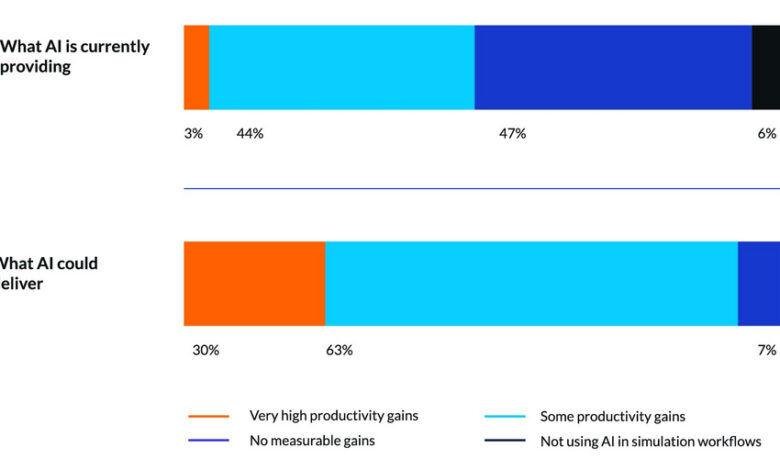
SimScale’s 2025 State of Engineering AI report reveals how data silos, legacy tools, and leadership gaps are stalling progress—while leading adopters show a clear path forward
MUNICH–(BUSINESS WIRE)–#AI–A new global survey of engineering leaders reveals that while nearly all expect productivity gains from AI in their design and simulation workflows, only 3% are seeing high productivity gains today—signaling an urgent expectation-execution gap that risks holding back innovation across critical industries.
The State of Engineering AI 2025 report, published today by SimScale in partnership with Global Surveyz, surveyed 300 senior engineering leaders from large enterprises (1,000+ employees) across the US and Europe. It provides one of the first clear benchmarks of AI readiness in the engineering sector—highlighting the cultural, process, and technology barriers that remain in place despite soaring expectations.
“Engineering leaders see the potential of AI—but knowing isn’t doing,” said David Heiny, CEO at SimScale. “The challenge is no longer about believing in AI’s promise, but about overcoming the very real systemic blockers that stop teams from scaling it successfully.”
Key Findings:
-
AI ambition far outpaces execution:
93% of engineering leaders expect AI to deliver productivity gains, with 30% anticipating very high gains. But just 3% report achieving that level of impact today. (see figure 1)
-
Cloud-native adopters pulling ahead:
Organizations using cloud-native simulation tools are 3x more likely to have mature AI programs and 6x more likely to have clean, centralized data—critical for scaling AI. They are also twice as confident in achieving AI goals within the next 12 months.
-
Siloed data and legacy tools remain top barriers:
55% cite siloed data and 42% cite legacy desktop CAE tools as major blockers—highlighting a foundational infrastructure gap across many organizations.
-
Leadership misalignment is slowing progress:
42% of CTOs cited resistance to AI adoption within technical teams—but engineer team leaders themselves report resistance just 29% of the time, suggesting technical teams are more open, ready, and motivated to adopt AI than leadership assumes.
-
AI is seen as a growth driver, not just an efficiency play:
Engineering leaders expect AI to fuel greater design innovation (54%), engineering productivity (51%), and faster time to market (47%)—with reduced costs ranking lowest on the list of expected benefits.
The “3% Club”: What the Most Progressive Teams Do Differently
Despite the widespread expectation-execution gap, a small but growing group of engineering leaders— the “3% club” — are already driving transformational outcomes with Engineering AI. Their success is not down to more AI ideas, but stronger execution muscle. They share four key traits:
- Modernized Engineering Architecture: They’ve eliminated siloed, desktop-era toolchains in favor of cloud-native platforms. Their engineering data is centralized, accessible, and structured — using open formats and APIs.
- Integrated Agentic Workflows: These teams are building and integrating AI agents directly into live workflows — not as bolt-on tools, but as embedded decision-makers at setup, evaluation, and optimization stages.
- Fast Path from Prototype to Loop: They test in low-risk settings, but move quickly to real-world, in-the-loop deployment — proving value in weeks, not years.
- Treat Data & Models as Infrastructure: They log and version everything — from simulations to models — enabling AI to be scaled, trusted, and portable across their tools and processes.
“This report isn’t just a warning—it’s a path to the winning formula,” said Jon Wilde, VP of Product at SimScale. “Forward thinking teams are proving that Engineering AI can deliver significant changes in innovation and performance. The execution gap for others is not technical feasibility — it’s architectural and organizational readiness. Now it’s about helping those companies make that leap with confidence—before the gap becomes too wide to close.”
About the Research
The State of Engineering AI 2025 is based on an independent survey conducted by Global Surveyz in June 2025, covering 300 senior engineering leaders across the US, UK, and Germany, and across six core industries: industrial machinery, automotive, electronics, life sciences, energy, and AEC.
The full report is available to download at: http://simscale.com/state-of-engineering-ai
About SimScale
SimScale is advancing the future of engineering with the world’s first AI-native engineering simulation platform. Trusted by more than 700,000 users, SimScale empowers engineers everywhere to innovate faster by exploring 1000’s of engineering decisions in seconds. By integrating AI workflows with computational fluid dynamics (CFD), finite element analysis (FEA), electromagnetic, and thermal simulation in a single cloud-native platform, SimScale empowers teams to engineer the irreplaceable. For more information, visit www.simscale.com.
Contacts
Media Contact:
John Webster
VP Marketing, SimScale
[email protected]
+49 89 8091327 70





